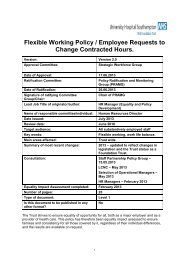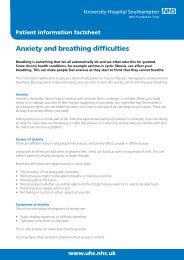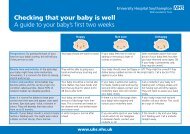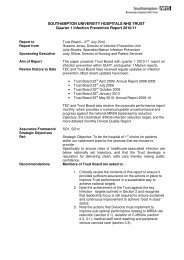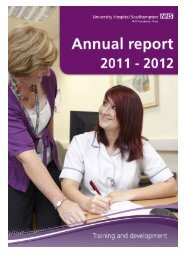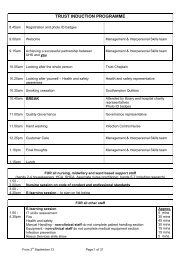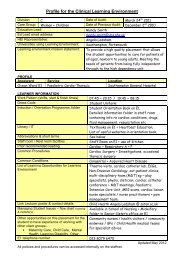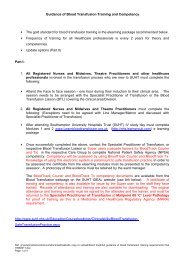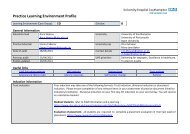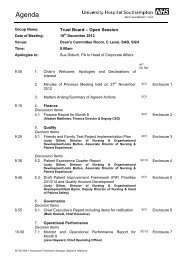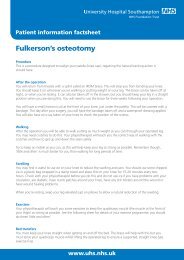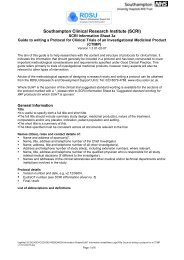its early days was Mr Reggie Fulton who was a tower <strong>of</strong> strength in raising funds and recruiting members particularly fromlocal schools.The League <strong>of</strong> Friends grew rapidly and performed an invaluable <strong>service</strong> in providing funds and also acting as animportant link between the hospital and the general public. The main fund raising events were the twice-yearly fairs whichwere held at Winchester Road in the spring and at Bursledon in the autumn. A regular attender at the former was DrHorace King, M.P. for Itchen and Speaker <strong>of</strong> the House <strong>of</strong> Commons. At the Autumn fair there was usually an exhibition<strong>of</strong> painting by the children in the Annexe some <strong>of</strong> which reached a very high standard. Starting on a relatively modestscale with gifts <strong>of</strong> knitted garments, toys, television, out-door play equipment, etc the Friends soon undertook moreambitious projects. In collaboration with the ‘Elfin’ School <strong>of</strong> Dancing and local W.I.s, they decorated and furnished the‘Mothers Room’ at Winchester Rd and later provided large play huts at both Winchester Rd and Bursledon which werealso used for nurses recreation in the evenings.They also redecorated and furnished hospital chapel as amemorial to Peter Lynch the young son <strong>of</strong> a member <strong>of</strong> thehospital staff. On a more personal level the Friends provided atea trolley for visitors at Bursledon on Sunday afternoons aswell as canteen workers and ‘hostesses’ for out-patients also‘play ladies’ and librarians in the wards. On occasions too, inresponse to appeals from matron, members <strong>of</strong> the Leaguewould temporarily take over duties in the kitchen or on thewards when there was a staff crisis. Later the Friends turnedpart <strong>of</strong> their attention to providing major medical equipmentsuch as piped oxygen in the wards and an image intensifier X-ray. Since the move to the General <strong>Hospital</strong> in 1974 theFriends have continued to support the Children’s Unit thereand at Bursledon until it closed. Visitors to Bursledon could notfail to notice two large play items in the grounds; one was analmost life sized steam engine presented by apprentices at Hawker Siddely and the other an enormous boot-house fromthe Eastleigh Carnival.Mention must also be made <strong>of</strong> the ‘Jackdaw Fund’, This was money collected by the jackdaws in their aviary in East Park.The birds would take coins <strong>of</strong> all denominations from visitors and place them in a container. They started collecting in1948 and by 1955 had taken 38441 different coins averaging over £4 per week. This money was presented to the hospitaleach year, over many <strong>years</strong>, by Mr Moody their keeper and usually put to the purpose <strong>of</strong> purchasing some desirable item<strong>of</strong> equipment; in 1957 he presented a £400 for an incubator.PAEDIATRICS IN WESSEXIt is not possible to follow the development <strong>of</strong> the Children’s <strong>Hospital</strong> in the N.H.S. separately from that <strong>of</strong> paediatrics inthe Region generallyThe first step towards establishing a paediatric <strong>service</strong> in Wessex was the appointment <strong>of</strong> Dr George Ormiston asPaediatrician in February 1947 with responsibilities both at he <strong>Southampton</strong> Children’s and Royal Hampshire county<strong>Hospital</strong>s. His salary was to be £500 each from <strong>Southampton</strong> and Winchester. The term “Paediatrician” was quite new tothis country at this time, having been introduced from North America in the thirties. It is a curious fact that although manychildren’s hospitals were founded in Britain in the second half <strong>of</strong> the nineteenth century only a handful <strong>of</strong> doctors in thiscountry were specialising entirely in childhood illness prior to World War II.At their London H.Q. in November 1949 the Regional Board made three simultaneous appointments viz:- Dr JohnMoseley to the Portsmouth and Isle <strong>of</strong> Wight districts, Dr A.P. Norman to Bournemouth, Dorset and Salisbury, and myselfto <strong>Southampton</strong>. Winchester and Alton.Dr Moseley’s base was at St Mary’s <strong>Hospital</strong> in Portsmouth where he had two large upstairs wards without washbasins, inan old fashioned block. He had a further 20 children’s beds at Portsmouth Royal <strong>Hospital</strong>. Like ourselves he wasexcluded from access to the neonates in the maternity department for several <strong>years</strong>. At Ryde in the Isle <strong>of</strong> Wight therewere 20 children’s beds in the care <strong>of</strong> Dr A Miller. Dr Moseley paid weekly visits there and also to the neonates atNewport.In Bournemouth, Dr Norman had two very gloomy children’s wards in the ex-Poor-law institution at Christchurch. He heldout-patient clinics at the Royal Victoria <strong>Hospital</strong> in Boscombe and at the Cornelia Cottage <strong>Hospital</strong> at Poole. He also hadbeds and clinics in the Dorset County <strong>Hospital</strong> in Dorchester and at the Weymouth and District <strong>Hospital</strong>. In Salisbury hehad a ward at the ex-U.S. Army hutted hospital at Odstock with an O.P. clinic at the General Infirmary.As well as the Children’s <strong>Hospital</strong> in <strong>Southampton</strong> and the Bursledon Annexe, Dr Ormiston and I had a small children’s
ward <strong>of</strong> about 25 beds, in a separate annexe, at the Royal Hampshire County <strong>Hospital</strong> in Winchester. We did not at firsthave access to the newborn in the Maternity Unit at the General <strong>Hospital</strong>. At the time many obstetricians were unwilling tohand over the care <strong>of</strong> the neonates to paediatricians and I must confess that I personally had had practically no training orexperience in neonatology when I was appointed. However, in Winchester, Dr John Penny and Mr Phillip Mitchell werevery willing to give us the run <strong>of</strong> their nurseries and we established a happy and, I think, efficient <strong>service</strong> there.Unfortunately this happy state <strong>of</strong> affairs at Winchester came to an abrupt end when Dr Penny had to retire early for healthreasons and his successor did not hold with paediatricians caring for “his” babies. A bitter dispute ensued which, in spite<strong>of</strong> strong support from the Regional Board, we lost. In the meantime Mr Knowlton and Mr Kilgour at <strong>Southampton</strong> hadrelented and we were now involved, though at first only partially, at the Maternity Unit.Within a year <strong>of</strong> his appointment Dr Norman left to join the staff <strong>of</strong> Great Ormond Street and we in <strong>Southampton</strong> coveredhis area for several months until Dr David Beynon was ready to take over. Dr George Crawshaw who had been our firstregistrar, took over West Dorset as temporary paediatrician. He held this post until December 1955 when Dr DavidVulliamy was appointed.The Wessex Region seceded from the S.W. Metropolitan Region in 1959 having its headquarters In Winchester with thedynamic Dr John Revans as Senior Administrative Medical Officer. Dr Neville Butler was appointed to take over theSalisbury district from Dr Beynon as well as Swindon, which had been separated <strong>of</strong>f from the Oxford Region.We in <strong>Southampton</strong> again had to cover Bournemouth and Poole during Dr Beynon’s long illness though Dr PamelaDavies acted as locum for some <strong>of</strong> the time and again after his tragic death. Dr Beynon was replaced in Bournemouthand East Dorset in September 1961 by Dr Michael Simpkiss.Dr Butler resigned in 1963 to join the staff at Great Ormond Street and Dr Ormiston retired in the same year, This seemedto be an opportune time to reorganise the paediatric <strong>service</strong> in central Wessex. Under the new arrangement Dr JohnGreaves from Teeside took over Winchester with some sessions at <strong>Southampton</strong> and Dr Hughes Davies took overSalisbury with sessions at Winchester and <strong>Southampton</strong>, while I concentrated mainly at <strong>Southampton</strong> with some sessionsat Salisbury. The object <strong>of</strong> this reorganisation was intended to give each paediatrician a place at the <strong>Southampton</strong>Children’s <strong>Hospital</strong> while providing a second string at each <strong>of</strong> the district hospitals to cover <strong>of</strong>f-duty, but it was asomewhat cumbersome arrangement and Dr Hughes Davies soon decided to relinquish his sessions at Winchester. DrLilian Jones took on Swindon in 1964.During the fifties I had established peripheral out-patient clinics in Lymington, Basingstoke, Andover and Hythe. Soonafter his appointment, Dr Greaves improved the cover at Basingstoke and Andover and started a new clinic at Alton.At Portsmouth Dr George Lewis was appointed in July 1965 to support Dr Moseley and in December 1969 Dr TerryMacIntosh was appointed to Basingatoke with some sessions at Winchester, In 1973 he was joined by Dr Judith Darmadywhose contract also included some sessions in Community Paediatrics; the first such contract in Wessex and perhaps inthe U.K.. The importance <strong>of</strong> maintaining pr<strong>of</strong>essional ties with our colleagues stimulated the formation <strong>of</strong> the S. W.Metropolitan Paediatric Club early in the 1950s. Meetings were held at the various centres <strong>of</strong> the Region. However, withthe independence <strong>of</strong> Wessex, which was unique at the time in not having a medical school, loyalties tended to changeand close links were forged with Bristol. Pr<strong>of</strong> Victor Neal and Dr John Apley were particularly helpful and welcoming.Most paediatricians from Wessex joined the South West Paediatric Club which held two meetings each year, the winterone in Bristol/Bath and the summer one at a peripheral centre, We hosted the summer meeting <strong>of</strong> the club in 1967. It wasnot until about 1968 that there were enough paediatricians in Wessex to justify the founding <strong>of</strong> our own club.The establishment <strong>of</strong> the Wessex Medical School in 1971 and the appointment <strong>of</strong> Dr Colin Normand as Pr<strong>of</strong>essor <strong>of</strong> ChildHealth at <strong>Southampton</strong> opened a new chapter for paediatrics in the region. Students were to obtain a significant portion <strong>of</strong>their clinical experience at various regional centres and many <strong>of</strong> the consultant paediatricians were given the titles <strong>of</strong>‘Honorary Clinical Tutor’.Various specialised <strong>service</strong>s were developed on a Regional basis though few were particularly orientated towardschildren.Mr John Atwell’s appointment in 1969 marked the beginning <strong>of</strong> a Regional Paediatric Surgical <strong>service</strong>, which was to bewidely developed.The regional Orthopaedic <strong>service</strong> was based on Lord Mayor Trainers <strong>Hospital</strong> at Alton. Although included in both DrOrmiston’s and my own contracts we never succeeded in establishing a footing in that hospital.The Cardio-thoracic <strong>service</strong> was based on the Chest (Western) <strong>Hospital</strong> and cardioiogists held peripheral clinicsthroughout the region <strong>of</strong>ten in conjunction with local paediatricians.Children for Plastic Surgery and those with severe burns were treated at the Regional Unit at Odstock. Other children withunusual or difficult problems continued to be referred to London and other centres.I am very grateful to my colleagues Dr Mary Capes and Dr Leslie Bartlet for providing the following accounts <strong>of</strong> thedevelopment <strong>of</strong> the Child Psychiatric Services in our area,



